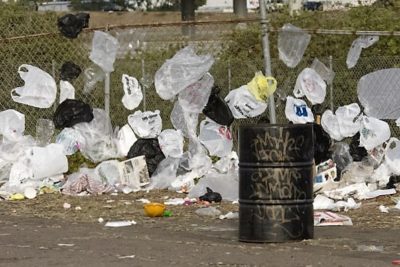Of Initiative Wars, Plastic Bags and Poison Pills
Deciphering California’s (Intentionally) Confusing Plastic Bag Propositions
California’s longstanding efforts to eliminate single-use plastic bags from the marketplace and the environment have finally reached California voters.
The November 8th general election ballot contains a breathtaking 17 separate propositions–16 proposed initiative measures and one referendum measure. Propositions 65 and 67 both deal with the same subject–a proposed ban on single-use plastic bags. Those dueling measures are confusing–intentionally so.
To understand those measures and the political intrigue involved, a bit of background is required. For years, environmental organizations have lobbied to ban ubiquitous single-use plastic bags from grocery, drug and convenience stores, because so many of the non-biodegradable bags wind up in landfills, or worse. They clog sewers and sewage treatment plants, and form a particularly noxious threat to the ocean environment. They often entangle (“entrain”) fish, seabirds and marine mammals, and contribute to the massive plastic “dead zones” that have formed in the Pacific Ocean and other marine environments.
In recent years, some 147 California local governments have responded by enacting local bans on state retailers’ distribution of single-use plastic bags. By 2014 a consensus had emerged among environmentalists and California retailers that a statewide approach to the plastic bag problem made more sense. As I recounted in a previous post, the California Legislature responded by passing a statewide ban on plastic bags (SB 270 (Padilla) in September 2014. It was scheduled to take effect in stages, beginning in 2015 and in full this past July. It allowed California retailers to offer recycled paper (but not plastic) bags for a charge of no less than 10 cents per bag.
But the plastic bag industry, which had been outflanked in the Legislature by the 2014 local government/environmental/California retailer political coalition, had only begun to fight. As explained in another, prior post, the industry–composed mainly of out-of-state companies–expended millions of dollars to qualify a referendum measure for the November 2016 ballot that asks the voters to decide whether or not SB 270 should take effect. (In the meantime, per California election law, SB 270’s implementation is suspended pending the statewide vote.) That referendum measure appears as Proposition 67 on California’s November 8th ballot.
Seems pretty straightforward, doesn’t it? But appearances can be deceiving–particularly in an election year.
Less publicized is another ballot measure that the plastic bag industry has quietly also qualified for the same November election ballot. Proposition 65 is an initiative measure–one presented directly to state voters without prior action by the Legislature. The most prominent provision in Proposition 65 would shift the proceeds of the 10 cent charge for paper grocery bags from retailers, in favor of a new account to fund various environmental good works. That provision would serve the plastic bag industry’s interest in retaliating against California retailers who had abandoned the industry by supporting SB 270 in 2014. And it might encourage California voters–and especially the environmental community–to support Proposition 65 on the assumption that it’s an environmentally friendly measure.
But that would be a big mistake. Proposition 65 represents a cynical industry ploy to confuse California voters. Several polls indicate a statewide ban on plastic bags is politically popular, and would likely be passed overwhelmingly (in the form of a Yes vote on Proposition 67) if that were the only plastic bag-related measure on the November ballot. But the goal of the bag industry is to confuse voters into thinking that their Proposition 65 is the preferable measure, and that it should be approved by the electorate as superior to Proposition 67. And Proposition 65 is nothing more than an electoral Trojan horse created by the industry opponents of any California statewide plastic bag ban.
The industry’s cynical strategy makes sense only when one studies the fine print of Proposition 65. Buried deep in the initiative, section 6(a) provides that if both Propositions 65 and 67 are approved by the voters, and Proposition 65 obtains more “Yes” votes than Proposition 67, then Proposition 65 “shall be deemed to be in conflict” with Proposition 67, and that “the provisions of [Proposition 67] shall be null and void.” This is what is known in the world of initiative politics as a “poison pill” provision.
The key point is that Proposition 65–unlike Proposition 67–contains no provision banning plastic bags. Proposition 65 only provides that if some other valid California law imposes a 10 cent fee for paper bags, that fee should not be retained by grocers, but instead diverted to fund other programs. So the bag manufacturers–at a minimum–have created a decent legal argument that the SB 270/Proposition 67 plastic bag ban doesn’t take effect even if voters approve that measure on November 8th, if Proposition 65 obtains more favorable votes. (Indeed, one more extreme reading of Proposition 65’s poison pill provision is that it would also supersede plastic bag bans previously enacted by California local governments.)
Still confused? Then let me try to simplify things. If you’re a registered California voter who supports implementation of California’s statewide ban on single-use plastic bags without further delay, vote Yes on Proposition 67 and No on Proposition 65.

Reader Comments
5 Replies to “Of Initiative Wars, Plastic Bags and Poison Pills”
Comments are closed.






Yikes, you refer to “Prop 47” in the body and conclusion when you mean Prop 67. Please correct. Otherwise great article.
Good catch. Correction made. Thanks.
There is NO Prop 47 on this ballot, so in your final paragraph, you mean “Vote Yes on Prop 67 and No on Prop 65.” Please correct this so I can repost this on social media
Good catch. Correction made. Thanks!
Can you explain what is meant by, “…then Proposition 67 “shall be deemed to be in conflict” with Proposition 67, and…” or clarify that it is a typo?